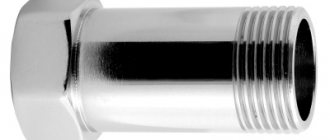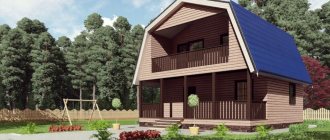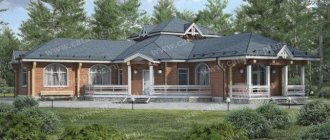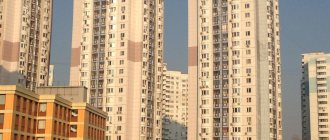What is design documentation for construction
According to the Town Planning Code of the Russian Federation, reconstruction or construction of any linear structure or capital construction facility is possible only if design documentation is available.
Project documentation is a set of graphic and text documents that contain all the information that reveals functional, architectural, design and engineering solutions for construction work.
Starting such work in the absence of a project is a direct violation of current legislation.
List of used literature
According to the generally accepted structure of writing a creative project, after the conclusion there is a list of used literature - this is a list of sources of information on the basis of which the project work was carried out (cited, mentioned in the text, used in the process of working on the project, but not reflected in the main text of the work). The list is compiled in alphabetical order.
Bibliographical references are used when quoting, borrowing, or mentioning a particular document.
Types of bibliographic references:
- according to the composition of the elements, the link can be complete or short;
- By location, intratextual, interlinear, and extratextual links are distinguished;
- when repeating references to the same object, primary and secondary references are distinguished;
- if there are several link objects, they are combined into one complex link.
Why do you need project documentation?
Working documentation is needed not only because it is required by law. Construction of the facility according to the project ensures the solution of a number of important tasks:
- even before the start of the construction process, determine the compliance of the facility being reconstructed or built from scratch with the requirements of technical regulations;
- establish compliance of the object with the technical design specifications;
- establish exact deadlines for construction work;
- draw up the estimate necessary to allocate budget funds for the construction of the structure;
- obtaining approval of construction from adjacent owners and necessary departments;
- prevent unexpected costs and significantly reduce the overall cost of construction;
- avoid global mistakes during the work and take into account all legal requirements and customer wishes;
- obtain permission to carry out construction work.
The development of design and technical documentation minimizes the risks of errors and unexpected “surprises” for both the customer and the contractor.
In addition, the project is necessary for putting an already constructed structure into operation, as well as for servicing the building in accordance with its purpose.
Clichés for term paper (main part)
Cliche phrases for the first chapter:
- The key concepts for our study are….
- ... called...
- On the official website... we found the following definition of the term... "..."
- Ivanov V.V. in the book... defines the concept... as...
- Klyuev S.S. understands the term...
- Petrov V.S. considers...as...
- Andreev A.A. in the book "..." gives the following definition...
- … - This …
- The site... offers the following definition of the concept...
- Ivanov’s article “...” in the magazine “...” states that...
- It is generally accepted that...
- First, let's look at the history of the issue...
- It is generally accepted...
- The history of the issue is covered in detail on the pages of modern encyclopedias, for example..., as well as on the website...
- From the book...we learned that...
- According to the position of Usov I.N., expressed in the article ... “...”, ...
- According to Ivanov V.V. ...
- Perhaps this is related...
- Besides, …
- At the same time...
- It's interesting that...
- It is a common belief that...
- It is important to note that...
Cliche phrases for the second chapter (empirical):
- In order to find out... we decided to conduct a survey... among the students/parents of our class. The survey was conducted through a questionnaire/social media survey.
- The survey involved ... students and ... parents. Respondents were asked the following questions: ...
- The study was conducted on the material…
- We took… as material for the study.
- The examples given are based on...
- The results of the survey are presented in Table 1. Figure 2 shows...
- In Figure 3 you can see...
- In this case we see ... / we are dealing with ...
- At the same time, it should be noted...
- Noteworthy is the fact that... The diagram shows...-
Now you see that the main part of the coursework is the most voluminous and impressive piece of work. And if you suddenly don’t have the time or energy to write it yourself, the student help service will help.
Who has the right to develop documentation
The preparation of technical documentation for construction can be carried out by legal organizations or individual entrepreneurs who have all the necessary licenses and permits to carry out such work.
An organization or individual entrepreneur acting as a general designer, when preparing documentation, has the right to involve other specialists or carry out all design activities independently.
If the developer is a member of the SRO for architectural and construction design, then he has the right to independently develop the project.
An important point is that the designer bears full responsibility for the compliance of the documentation with the requirements established by technical regulations and its quality.
Composition of project documentation
The requirements for the composition of sections of documentation are clearly regulated by paragraph 13 of Article 48 of the Town Planning Code. In addition, Decree of the Government of the Russian Federation No. 87 contains a list of requirements.
The resolution established that the project must consist of two interconnected parts - text and graphic. The text contains all the information about the technical characteristics of the object, provides links to all technical and regulatory documents used in the design, and justifies the feasibility of the decisions made.
Graphic consists of diagrams, drawings, plans and other schematic materials.
The composition of design documentation for construction for production and non-production capital construction projects consists of 12 sections:
- Section 1 – Explanatory note.
- Section 2 – Scheme of planning organization of the land plot.
- Section 3 – Architectural solutions.
- Section 4 – Constructive and space-planning solutions.
- Section 5 – Information about engineering equipment, engineering support networks, list of engineering activities, content of technological solutions.
- Subsection – Water supply system.
- Subsection – Drainage system.
- Subsection – Heating, ventilation and air conditioning, heating networks.
- Subsection – Communication networks.
- Subsection – Gas supply system.
- Subsection – Technological solutions.
- Section 6 – Construction organization project.
- Section 7 – Project for organizing work on the demolition or dismantling of capital construction projects.
- Section 8 – List of environmental protection measures.
- Section 9 – Measures to ensure fire safety.
- Section 10 – Measures to ensure access for people with disabilities.
- Section 10.1 – Measures to ensure compliance with energy efficiency requirements and requirements for equipping buildings, structures and structures with metering devices for energy resources used.
- Section 11 – Estimate for the construction of capital construction projects.
- Section 12 – Other documentation in cases provided for by federal laws.
Sections of design documentation for linear objects are as follows:
- Section 1 – Explanatory note.
- Section 2 – Right-of-way design.
- Section 3 – Technological and design solutions for a linear facility. Artificial constructions.
- Section 4 – Buildings, structures and structures included in the infrastructure of a linear facility.
- Section 5 – Construction organization project.
- Section 6 – Project for organizing the demolition (dismantling) of a linear facility.
- Section 7 – Environmental protection measures.
- Section 8 – Measures to ensure fire safety.
- Section 9 – Construction estimate.
Resolution No. 87 provides detailed information on the requirements for the content of projects. Ready-made documentation is completed separately for specific sections and subsections. Tables A.1 and A.2 of GOST 21.1101-2013 show all the names of sections and their codes.
Basic kit drawings
- AR-1: General data;
- AR-2: General data (continued);
- GP-3: Situation plan M 1:2000;
- GP-4: Base plan M 1:500;
- GP-5: General plan M 1:500;
- GP-6: Improvement plan M 1:250;
- AR-7: 1st floor plan;
- AR-8: 2nd floor plan;
- AR-9: Facade 1-3;
- AR-10: Facade VA;
- AR-11: Facade A-B;
- AR-12: Facade 3-1;
- AR-13: Section 1-1;
- AR-14: Section 2-2;
- AR-15: Roof plan;
- AR-16: General view (Perspective);
- AR-17: Wall developments with ventilation ducts;
- AR-18: Specification of elements for filling openings;
- AR-19: Floor Inventory.
Working drawings of VK (water supply and sewerage)
- Common data;
- Water supply and sewerage 1st floor plan;
- Water supply and sewerage 2nd floor plan;
- Water supply and sewerage system diagram B1, T3, K3.
, Where,
- B1 – domestic water supply;
- T3 – Hot water pipeline;
- K1 – Domestic sewerage.
Working drawings of OV (heating and ventilation)
- 1-2 General data;
- 3 Heating by radiators 1st floor plan;
- 4 Heating by radiators, 2nd floor plan;
- 5 Heating “warm floor” 1st floor plan;
- 6 Heating “warm floor” 2nd floor plan;
- 7 Heating system diagram;
- 8 Connection of distribution manifolds No. 1, No. 2 Heated floor;
- 9 Ventilation of the 1st floor
- 10 Ventilation of the 2nd floor
- 11 Schematic diagram of the combustion chamber
- 12 Fragment of the furnace plan, distribution comb;
- 13 -14-15 Equipment specifications
- There is a table of heat transfer resistance of external walls.
- There are specifications for materials and equipment.
Now more details.
Codes of sections of project documentation
- PZ - Explanatory note.
- ROM - Scheme of planning organization of a land plot.
- AR – Architectural solutions.
- KR – Constructive and space-planning solutions.
- IOS – Information about engineering equipment, engineering support networks, a list of engineering activities, the content of technological solutions.
- POS – Construction Organization Project.
- POD – Project for organizing work on the demolition or dismantling of capital construction projects.
- Environmental Protection – List of environmental protection measures.
- PB – Measures to ensure fire safety.
- ODI – Measures to ensure access for people with disabilities. 10. 1 TBE – Requirements for ensuring the safe operation of a capital construction facility.
- SM - estimate for the construction of capital construction projects. 11.1 33 – Measures to ensure compliance with energy efficiency requirements and requirements for equipping buildings, structures and structures with metering devices for energy resources used.
- Other documentation in cases provided for by federal laws, including: GOES - List of civil defense measures, measures to prevent natural and man-made emergencies, measures to counter terrorism. DPB – Declaration of Industrial Safety of Hazardous Industrial Facilities. DBG – Declaration of Safety of Hydraulic Structures.
Design stages
Complex design includes a number of stages.
- Obtaining initial information . Collection of information to simplify the preparation of a construction project. Experts assess the possibility of starting construction, identify potential problems and ways to solve them. As part of the design work, a building concept is created.
- Preparation of a feasibility study . Engineers are preparing a feasibility study. The document determines the feasibility of certain construction solutions, as well as the amount of costs associated with the design and construction of the building.
- Coordination of technical specifications . Studying the technical specifications provided by the client. Each item undergoes the necessary approval. If there are controversial issues, universal solutions are selected that suit both parties. In some cases, the technical specifications are formed by the specialists developing the project.
- Layout of the preliminary design . Creating a building concept and visualizing technological solutions to get a general idea of the facility.
- Preparation of a general development plan . Formation of a project for the construction area. A possible development site is being studied, construction on which is possible in the future.
- Registration of technical specifications . Preparation of technical conditions necessary for connection to utility networks. Specifications are developed taking into account the parameters of the construction site, as well as the characteristics of the resources that are planned to be supplied.
- Direct development of the project . Documenting all design decisions, creating graphic and text materials, taking into account the research results. It is possible to carry out other activities necessary for the design of key components. The finished set of design solutions is approved by the customer.
- Working with supervisory authorities . Checking the construction project by state (non-state) experts, passing the necessary approvals.
- Development of working documentation . Preparation of a set of design solutions regulating the organization and implementation of construction according to the agreed project. The RD includes architectural, structural and technological solutions. There are sections dedicated to engineering networks (HVAC, NV, EO).
The company takes a responsible approach to design, ensures the selection of optimal solutions that guarantee economically feasible construction of buildings and other facilities.
What documents should be present in the project documentation
A well-drafted project must fully present to the customer not only the entire list of upcoming work, but also the predicted results of their implementation. Therefore, it must contain a large number of different documents, which are divided into three main parts of documentation: design, working and estimate.
The design materials must set out the main technical and engineering aspects of the construction work, in particular:
- general information about the construction project;
- schematic information and site layout;
- detailed work plan and scope;
- architectural solutions;
- types and characteristics of engineering equipment;
- fire safety data;
- information about communication equipment: heating, water supply and drainage, energy supply, ventilation and other systems;
- dismantling plan;
- solutions aimed at improving the energy efficiency of a building;
- solutions to create special conditions at the site for people with disabilities.
Working documents must contain information aimed at translating all design solutions into reality.
The design and estimate documentation of the facility must clearly present to the developer all financial expenses that will be incurred during construction. Calculations are carried out on the basis of working documents. The project must contain the following estimates:
- local – include primary documents, which are compiled separately for each type of work;
- consolidated - combine calculations from individual local estimates and determine the total cost of work on the reconstruction or construction of an object;
- for specific operations - necessary to establish a monetary limit for a certain type of work.
Along with the availability of generally established estimates, forecasts for special costs, expense summaries and other financial transactions can be additionally compiled.
Depending on the number of sections and the volume of information included in them, the terms of the project documentation necessary for the execution of drawings, calculations and collection of other materials are agreed upon.
Contents of the finished project drawings
To show what a finished house project looks like, I took as an example a working project of a house with an area of 537.2 square meters. meters, the so-called building volume, the house has 2 floors.
Typically, a completed project requires electrical drawings from the engineering department and estimates for materials and work. There are none in this project. As a rule, electricians and estimates are made when editing the project to meet the requirements of a specific customer.
So, a finished project for a 2-story house.
Types of project documentation
In order for construction to be carried out in full compliance with current legislation, the initial stage of the process should be the development of design documentation.
According to the typology of materials included in the project, the following types of project documentation are distinguished:
- general plan . Contains an image of the area to be developed, indicating the contours of existing and planned objects, defining the landscaping of the territory, and topographical features of the area;
- general drawings . Include drawings of facades indicating all architectural elements and the appearance of the structure, floor plans, diagrams of buildings in longitudinal and transverse sections with the location of utilities and ways of linking them together;
- parts drawings . Compiled for complex assemblies, indicating the geometric dimensions of all elements and parts of the structure, designating the specification, cross-section and mating of structural elements;
- project passport . This is a document that necessarily contains a brief description of the object, its image and main technical characteristics;
- explanatory note . It describes in detail all the information about the designed object: purpose, appearance, organization of internal space. The note must contain the main technical indicators of the structure and design features. There must also be an argument as to why this particular option will be the best design solution for a particular construction project;
- calculations _ To establish the parameters of buildings and individual structural elements, aerodynamic, thermal, physicochemical, hydraulic, seismicity and other calculations are performed. All results obtained are displayed in tabular or text form;
- estimates . They can be a separate section of the project or performed as an appendix to the documentation. In any case, estimates must be present, since construction cannot be carried out efficiently and effectively without accurately determining financial costs.
All of these types of materials make up certain sections of the design documentation. For a faster and more understandable perception of the information presented in the project, some drawings, graphs and diagrams are made in color. In axonometry, technical images are made and artistic images are drawn in perspective.
Detailed description of the parts of the finished house project
The finished project is conditionally divided into groups of working drawings, namely:
The first set of working drawings in the finished project is the Master Plan (GP). This is a set of six drawings:
- Situation plan, scale M 1:2000. On the plan we see the designed object, taken from outer space in the wind rose (photo 0003).
- Basic plan, scale M 1:500. The plan is also on a smaller scale (photo 0004).
- General plan, scale M 1:500. The plan shows a site plan with a house plan and explanations of areas and premises (photo 0005)
- Landscaping plan, scale M 1:250. On the plan, the same on a better scale.
Required and optional sections
For facilities whose construction or reconstruction work will be financed with budgetary funds, the following sections must be fully prepared:
- Construction estimate.
- Construction organization project.
- Measures to ensure energy efficiency requirements and equip facilities with metering devices for used electricity.
This list is established by Resolution No. 87, namely paragraph 7. In other cases, the need to compile the above sections, as well as their content, is determined at its discretion by the customer when agreeing on the design assignment.
But the absence of these sections is not acceptable in every case. For example, if the project does not have a “POS” section, then the developer will be denied a construction permit since its absence contradicts the requirements of clause 12 of Art. 48 of the town planning code.
The main part of the course work: what does it include?
In the main part, the author introduces us to the problem under study, summarizes the available information and looks for a solution, introduces other opinions, concepts and research on the topic.
It is in the main part that the author reveals the topic, solves problems, and examines in detail the object and subject of research.
The main part of the course work includes 2-4 sections, each of which is divided into paragraphs/points, which are smaller in volume than chapters. It consists of theoretical and practical (empirical) parts. In this case, the practical part may be absent if the work is purely theoretical in nature and has no practical orientation.
Other documentation included in the project
The list of sections of the project documentation contains “other documentation” provided for by law. What kind of documentation should be included in the project depends on the category of the object.
If construction is planned next to a cultural heritage monument, then the requirements of Federal Law No. 73-F3 are taken into account, justifying the need to develop measures aimed at the complete safety of such an object.
According to the Code of Rules 132.13330.2011, a section “Measures to combat terrorism” is included in the draft.
The section “Measures for the operation of capital construction projects” has also acquired particular relevance. When drawing up projects for residential buildings, its presence is mandatory.
Work order
Work on the design of buildings and other structures is carried out in a certain sequence.
- Filing an application . The client places an order for the preparation of the project. You can use phone, e-mail or website functionality. The processing time for an application for the design of a building and related structures depends on the workload of the organization and does not exceed several days.
- Meeting of the company representative with the customer. The partners discuss the features of the project and the nuances of cooperation. It is possible to work out wishes and suggestions from the client.
- Conclusion of an agreement . At the end of the negotiations, the parties sign an agreement establishing the responsibilities of the customer and the project executor.
- Departure of specialists to the site. Engineers collect information necessary to implement the project and conduct research.
- Development and approval of documentation . The company’s employees develop a project based on collected and prepared information and obtain the necessary approvals and approvals. Documents are prepared electronically and on paper.
- Submission of work . The client receives a complete set of project documentation approved by the relevant organizations and institutions.
Each project for a construction site is developed individually. This guarantees strict compliance with the technical specifications, absence of inaccuracies, errors and delays.
Initial data for drawing up the project
To begin design work, the customer must not only sign the contract, but also provide the design organization with the necessary initial data:
- design assignment for the developer. If the project is drawn up on the basis of a contract, then an assignment from the technical customer will be required;
- the customer must submit to the designer a town-planning plan for the land plot to be developed, and when drawing up a project for a linear facility, a land surveying and planning project;
- results of previously completed engineering surveys;
- technical conditions. Required when it is necessary to connect the facility to communication networks and engineering support systems.
Depending on the specific situation, the design organization may also require other documents necessary for the high-quality preparation of project documentation.
Our services for designing buildings and structures
As part of the comprehensive design of commercial buildings, the company provides a wide range of related services:
- approval of the architectural and urban planning appearance;
- assessing the potential of a building, site or unfinished construction site;
- development of solutions for the reconstruction of buildings and structures;
- design of all stages and sections, regardless of complexity;
- carrying out work to approve documentation in ISOGD;
- obtaining a building permit;
- carrying out engineering surveys necessary for the design of structures of the established configuration;
- obtaining permission to put the facility into operation.
Do you need advice on the design of buildings and structures?
Call us by phone or fill out the online form. Our specialist will answer questions in detail, clarify the nuances and offer the best option for mutually beneficial cooperation.
An organization of any level can order building design - IR-Proekt cooperates with representatives of small, medium and large businesses.
Development of design documentation for STU
If the requirements for the safety and reliability of an object established by regulatory documents are not enough, then according to clause 5 of PP No. 87, design must be carried out according to special technical conditions (STU).
These are technical standards developed for a specific object that determine the features of design, engineering surveys, construction work, operation of erected buildings and, if necessary, even dismantling of objects. They must be taken into account, otherwise the examination of the project documentation will be negative.
As an example of preparing a project according to STU, you can consider an apartment building, the height of which is more than 75 meters. Since the set of rules SP54.13130.2011 contains only standards for buildings up to 75 meters in height, therefore, such a house will require special technical conditions.
Economic justification for a creative project
In the economic part of the creative project, a full calculation of the costs of manufacturing the designed product is presented. The result of the economic calculation should be a justification for the cost-effectiveness of the designed product and the availability of a sales market.
Environmental justification for a creative project
Particular attention in the structure of a creative project in technology, and in other subjects, must be paid to the environmental assessment of the project: justification that the manufacture and operation of the designed product will not entail changes in the environment or disruptions in human life.
An environmental assessment of a project includes an environmental assessment of the design and manufacturing technology, an assessment of the possibilities of manufacturing a product from waste materials, and an assessment of the possibility of using waste generated during the implementation of the project.
Preparation of the project for individual construction stages
Paragraph 12_1 of Article 48 of the Town Planning Code states that the preparation of documentation can be carried out not for the entire construction process, but for individual stages of work on its construction or reconstruction.
A separate stage means the construction of one of the capital facilities or its separate part in the case when it can be put into operation independently of the other buildings on the same site.
The documentation must justify autonomy taking into account the planning structure, utility networks and structure of the structure.
conclusions
As you can see, a finished house project, completed by a high-quality construction organization, is a solid set of documents that allows you to build your own house.
However, when purchasing a ready-made project, you should always request that it be modified to suit you, changing the location of the house, the number of windows and doors, and other non-fundamental changes.
©Domity.ru
Articles construction
- Shallow foundation
- Everything about screw piles: pros and cons
- Do-it-yourself strip foundation installation
- Deep foundation
- Choosing the foundation of a wooden house
- USHP foundation - insulated Swedish plate
- Construction of a rubble concrete foundation
- Construction of a house base: types of house base
- Foundation ribbed floating slab (RPP)
- What is a strip foundation
Approval of project documentation
According to current legislation, the documentation drawn up must be approved by the relevant government agencies.
The compliance of the design documentation with technical regulations, the requirements of the urban planning code and other construction standards is subject to verification. The procedure for project approval in each case is determined depending on the type of object and the requirements for it.
A positive conclusion to the design documentation of a building or linear facility is possible only if there are no errors in it. Each document must strictly comply with regulatory standards.
Prices for the design of buildings and structures
The price list will help you find out what the cost of the construction project is. It contains a complete list of works and current tariffs.
| Real estate object | Cost, rub |
| Project development (Warehouse building up to 1500 sq.m.) | from 300,000 rubles |
| Project development (Industrial building up to 1500 sq.m.) | from 500,000 rubles |
| Project development (Warehouse building over 1500 sq.m.) | from 900,000 rubles |
| Project development (Industrial building over 1500 sq.m.) | from 1,300,000 rubles |
*excluding VAT, with a guarantee of approval of the project by ISOGD and obtaining a construction permit (excluding approvals, surveys, sanitary protection zones and other tasks)
Factors influencing cost:
- scope of activities for the design of buildings and other structures;
- time limit;
- availability of complex construction solutions for the project;
- the use of rare or non-standard materials during the construction of the facility;
- subsequent integration of equipment created according to a unique project.
Design costs are agreed upon before work begins.











